Is Onshoring The Road to Sustainable Supply Chains?
Companies can now relocalize their production more sustainably and efficiently with smarter supply chain planning on an integrated platform.
How Onshoring and Friend-Shoring Strengthen Sustainable Supply Chains
Onshoring can be a sustainable step in times of much-needed supply chain decarbonization, frequent disruptions and increasing social pushback from offshored employees. However, some companies are also considering friend-shoring so they are not limited to only domestic production. Whichever relocalization route they choose, one thing is clear: All roads to more sustainable supply chains start with smarter planning.
Delivering the right relocalization strategy requires preparation, yet not all companies are equipped to do so. More than 60% of them do not have the right tools1 to optimize their workflow assignment and supplier relationship management (SRM).
To address this gap and begin their onshoring journey, companies can turn to smart supply chain solutions on the 3DEXPERIENCE® platform.
Discover how below.
Onshoring: The Smart Road Home
Relocalize with an optimized supply chain.
Download our ebook to find out more.
Benefits of Sustainable Supply Chains for a Better Future
Reducing Environmental Impact
Sustainable supply chains help companies lower their carbon footprint and reduce environmental impact. Practices like onshoring improve sustainability, supply chain resilience, and operational efficiency.
Sustainable Sourcing and Circular Economy
Sustainable supply chains promote sustainable sourcing and responsible production. Integrating circular economy practices ensures efficient energy use, reduces waste, and encourages recycling across the value chain.
Contributing to Global Climate Goals
By adopting sustainable practices, companies support global climate goals, meet regulatory requirements, and satisfy the demand for eco-friendly products. Sustainable supply chains are essential for reducing emissions.
Utilizing Digital Software
Technologies like virtual twins and digital platforms give companies end-to-end visibility in their supply chains. This helps optimize resources and drive sustainable business transformation by aligning decisions with sustainability goals.
Three Strategies for Sustainable Supply Chain Optimization through Onshoring
With DELMIA’s smart supply chain planning solutions, companies can optimize their entire network in the three steps shown below.
1. Effective planning
Smarter, integrated planning on the 3DEXPERIENCE platform centralizes the data repository to speed up supply chain planning and optimization via two parts:
- Data-backed actions
- Integrated planning processes
Data-backed actions
With all critical data points in one place, companies have full supply chain visibility. This way, they can accurately model and simulate the outcomes of any planning scenario – and quickly respond to changes, risks and disruptions.
Integrated planning processes
A virtual twin of the supply chain comes with advanced scenario planning capability, which enables accurate predictive analysis. With it, companies can test different contingency plans and implement data-backed enterprise-wide changes.
2. Integrated collaboration
Collaborating in the platform’s secure collaborative environment results in better teamwork, improved workforce performance and greater enterprise-wide productivity. Check out our customer story for a real-life example of how it worked for them.
Customer Story: Amy's Kitchen
Discover how the organic foods manufacturer optimized their production via sustainable supply chain planning on the platform.
3. End-to-end cost reduction
Explore how the 3DEXPERIENCE platform’s virtual twin capability can help companies reduce supply chain cost.
Cost Projection
Simulate and test plans to review all revenue and profit options. Calculate demand variability against price changes. View cost-related data from any relevant point in the network.
Supply sourcing
Quickly compare alternative sourcing options to respond to changes on time.
Maintain healthy inventory levels with total stock visibility.
Profitability
Simulate what-if financial scenarios to change plans in real time.
Visualize the impact of any plan and decision on profitability.
Upscaling
Leverage advanced solutions that can scale up in parallel with business growth.
Easily incorporate new technologies and virtual capabilities.
Leveraging Technology for Sustainable Supply Chains Management
Technology plays a crucial role in achieving supply chain sustainability. Tools such as digital twins and AI-driven analytics allow companies to monitor, simulate, and optimize supply chain operations in real time. By utilizing platforms like 3DEXPERIENCE, businesses can gain full visibility of their entire supply chain, assess their environmental impact, and make informed decisions to minimize waste and energy consumption.
Moreover, advanced planning solutions help streamline supplier collaboration, improve inventory management, and support eco-friendly sourcing. These technologies are essential for driving sustainable supply chains and ensuring compliance with global sustainability goals.
FAQ About Sustainable Supply Chain
Related Content
Decarbonizing Industry Operations
Through digital transformation, industries can rethink their operations, from product design to supply chains, and move toward more sustainable, resource-efficient processes.
Supply Chain of the Future
How Digitalization, Virtual Twins, AI, and Emerging Technologies are Shaping Resilient, Agile, and Sustainable Supply Chains.
Sustainable Manufacturing
Sustainable manufacturing is the ability for manufacturers to leverage the latest technologies to reduce waste, cut energy use and improve efficiencies across the product lifecycle.
Circular Supply Chains: Reshape the Enterprise’s Value Network
Transform how you do business through circular supply chains to achieve profitability and lasting success.






